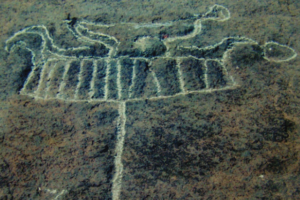Nandkumar M Kamat
This article is dedicated to the memory of former director of Goa archives and archaeology and a well-known Indologist and historian Prakashchandra Shirodkar who passed away on May 6 in Bengaluru. He will be remembered not only for his scholarly books and numerous publications, but also for his keen interest to get the globally important rock art location of Panasaimal- Kevan Dhanode in village panchayat of Kolamb Rivona on the banks of Kushavati river notified as a protected site besides extending similar protection to the monolithic petroglyphs at Cazur, Quepem.
Before his death, historian late Shirodkar was working on a detail monograph on the rock art of Konkan and Goa which could be ready for publication. The rock art of Goa had always existed, but people could not identify and interpret it. I still remember the ride with late Shirodkar in his official jeep on a very warm Sunday morning on May 9, 1993. I was invited to join the search team by the Ponda-based architect Kamalakar Sadhale and our local guide to the rock art site was a progressive farmer late Kalidas Sawaikar who owned a plantation close by. When we left Panaji, archaeologist Mangesh Deshpande and photographer Nayan Naik were with us. Young architect Abhijit Sadhale had accompanied his father from Ponda.
After reaching the riverbank site and after a quick inspection, by afternoon we came to the conclusion that it was a big discovery – a vast gallery of more than 120 prehistoric petroglyphs. I broke the exclusive news of the finding of about 120 petroglyphs mostly the geometric forms, petroglyphs of anthropomorphs, bovids, other zoomporphs and phytomorphs on the next day in this newspaper.
After this discovery, Shirodkar found the bovid zoomorphs at Cazur and a few more petroglyphs at Panasaimal. It is to his credit that he had the vision to conserve and protect that site for posterity. He worked hard to trace the ownership details of the location and then moved the file to officially notify the Kushavati rock art site as protected heritage. I made many visits to the site and then conducted independent studies from different angles like comparison of the extinct animals depicted in the Kushavati rock art gallery with present faunal biodiversity in the Western Ghats.
As a scholar, Shirodkar respected different viewpoints but he had the ability to understand the efforts of other scholars as well. So when I offered a different perspective on the unique ocular labyrinth at Panasaimal which I had examined for the first time with powerful image analysis software he was presiding over that session during the local history seminar at the Department of History, Goa University in 2004 and he encouraged me to explore the lead further.

Although I lost touch with him after he shifted to Bengaluru he kept track of the new discoveries of rock art in Konkan from Ratnagiri to Sawantwadi. Since he had announced that he was coming out with a major book on rock art of Konkan I keenly waited to explore what he had to say because dozens of national and international scholars like Austrian rock art researcher Erwin Neumayer, A Sundara, Themistocles Silva had visited Kushavati rock art gallery.
India doesn’t follow any systematic technique for dating such rock art so different researchers assign different dates to rock art. The entire Konkan rock art seems to be the creation of a shamanistic semi nomadic community which had just come out of the ice age.
On that boiling afternoon, May 9, 1993, on that bare hot rock surface we had no idea that it would be late, and we had not made any arrangements in that forested area for lunch. Then Shirodkar just summoned all of us to the other side of the shallow channel where Khandeparkar, the owner of a beautiful areca nut orchard offered us a place to sit and served tender coconut water. I asked Shirordkar what surprise he had for us. Then he opened a bag and removed lots of ripe Malcorada mangoes, got them sliced and served to all. He saw to it that everyone got enough slices. “When I left from Panaji, I knew it could be late and in the remote forest area we won’t get anything to eat so I carried the mangoes with me,” he said as we thanked
him profusely.
He was highly respected nationally and internationally as a historian but on that Sunday, I saw his very caring, friendly and humane side.
He had to struggle a lot for everything in his life because his father, the brave freedom fighter and ex speaker of Goa assembly P P Shirodkar was jailed for 15 years in Angola and was released only in 1962. Goa will never be able to forget the work and the immense pains taken by him to conserve and protect the precious historic heritage of the state.
Later during archivist Shankar Kamat Mhamai’s tenure as director of Goa archives, avimorphs were discovered and steps were initiated to landscape and beautify the Kushavati rock art site. Kamat Mhamai was bold enough to reject a proposal to open an iron ore mine of two million MT per year capacity within a few hundred metres from the notified site.
Local people say that what survived on the banks of Kushavati River could be just a fraction of what was destroyed by the mining and dumping activity in the surrounding area in the last century. Shirodkar’s all round contributions to historical research will never
be forgotten.
Courtesy: The Navhind Times, Goa. www.Navhindtimes.com

Is it okay to reference part of this on my website if I post a link back to this site?
I infatuation to to thank you for this astounding read!! I unconditionally enjoyed all bit of it. Ive got you photograph album marked to check out additional stuff you post
A round of applause for your article.Thanks Again. Want more.